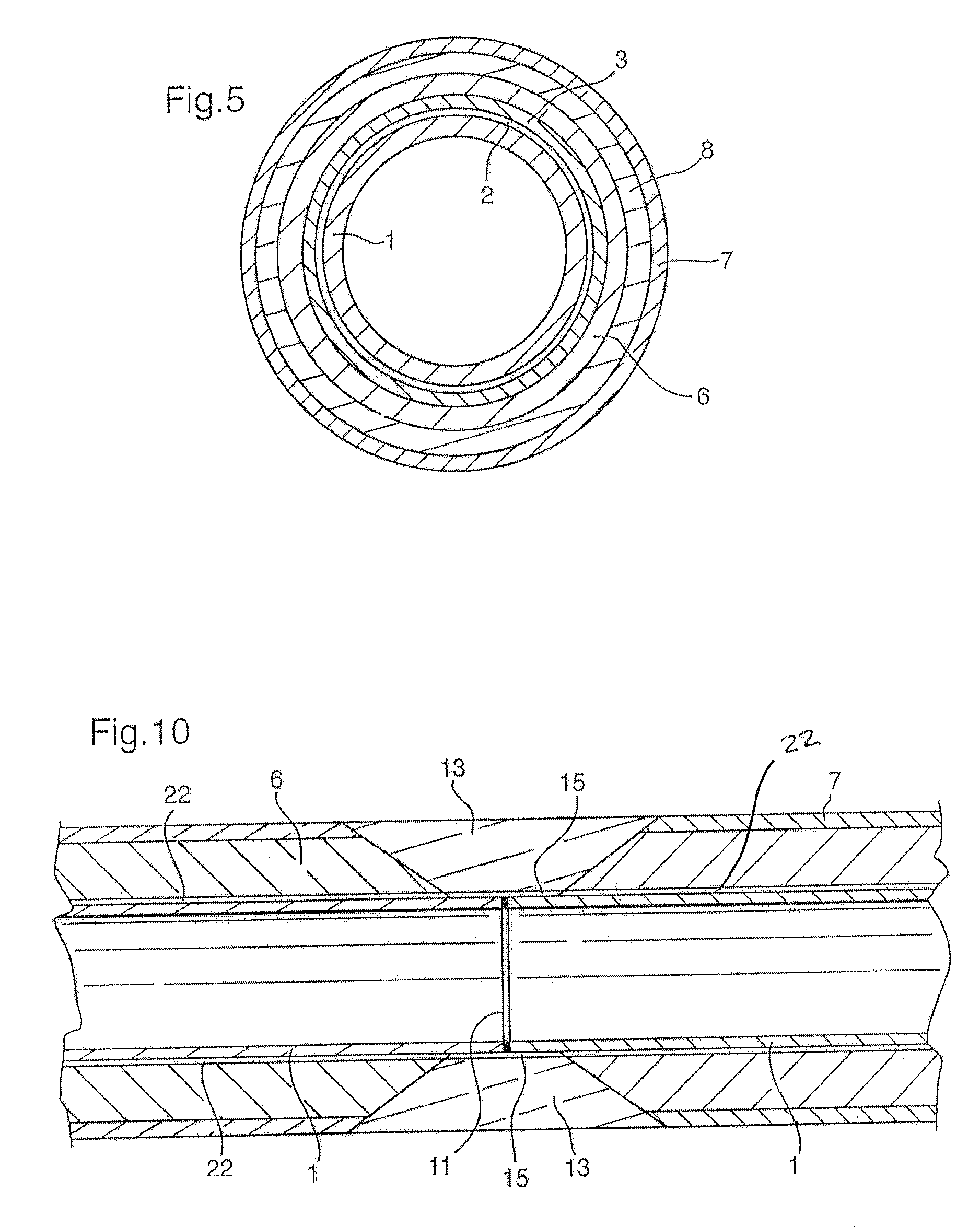High temperature resistant insulation for pipe
a technology of high temperature resistance and pipe, applied in the direction of flexible pipes, rigid pipes, non-disconnectible pipe joints, etc., can solve the problems of reducing or losing production, requiring the replacement of sections of pipelines or entire systems with corresponding asset value loss, and affecting the performance of the pipe, etc., to achieve high compressive strength, low thermal conductivity, and high thermal stability
- Summary
- Abstract
- Description
- Claims
- Application Information
AI Technical Summary
Benefits of technology
Problems solved by technology
Method used
Image
Examples
example 1
[0143]In this example a steel pipe 1 is provided with a three layer corrosion protection coating as described above in connection with FIG. 1, comprising a corrosion protection layer 2, an adhesive layer 3 and a topcoat 4. The steel pipe 1, which was surface-blasted and cleaned, had an outside diameter of 140 mm and wall thickness of 10 mm. The pipe 1 was pre-heated to a temperature of 200° C. and spray-coated with a 0.300+ / −0.100 mm thick layer 2 of fusion bonded high temperature epoxy powder (density 1400+ / −100 g / l), followed immediately by the extrusion on top of the epoxy of a 0.300+ / −0.200 mm layer 3 of a high temperature modified styrene-maleic anhydride copolymer adhesive (density 1.060 g / cm3 and melt flow rate 0.6 g / 10 min) and a 6.0+ / −1.0 mm topcoat 4 of solid polyphenylene oxide-polystyrene blend (density 1.060 g / cm3 and melt flow rate 8 g / 10 min.) at melt temperatures of 220° C. and 260° C., respectively. Extrusion of adhesive layer 3 and topcoat 4 was accomplished in seq...
example 2
[0144]The corrosion-protected pipe produced in Example 1 was further coated with a 20.0+ / −1.0 mm layer 6 of the same solid polyphenylene oxide-polystyrene blend (degree of foaming=0%) of topcoat 4 using an extruder equipped with a sheet die by preheating the outer surface of said corrosion-protected pipe to a temperature of around 220° C., and wrapping the polyphenylene oxide-polystyrene blend at a melt temperature of 260° C. on top of the preheated outer surface. The insulated pipe thus produced was tested for the properties noted in Table 3.
example 3
[0145]Using the coating procedure described in Example 2, the corrosion protected pipe produced in Example 1 was further coated with a 30.0+ / −1.0 mm layer 6 of the polyphenylene oxide-polystyrene blend of Example 1 foamed to a density of 0.945 g / cm3 (degree of foaming=10%) using 0.5% by weight of an endothermic chemical foaming agent, and an outer 5.0+ / −1.0 mm. layer 7 of solid high impact polystyrene modified with polyethylene (density 1.020 g / cm3 and melt flow index 4.0 g / 10 min.). The insulated pipe thus produced was tested for the properties noted in Table 3.
PUM
| Property | Measurement | Unit |
|---|---|---|
| Vicat softening point | aaaaa | aaaaa |
| temperatures | aaaaa | aaaaa |
| temperature | aaaaa | aaaaa |
Abstract
Description
Claims
Application Information
 Login to View More
Login to View More - R&D
- Intellectual Property
- Life Sciences
- Materials
- Tech Scout
- Unparalleled Data Quality
- Higher Quality Content
- 60% Fewer Hallucinations
Browse by: Latest US Patents, China's latest patents, Technical Efficacy Thesaurus, Application Domain, Technology Topic, Popular Technical Reports.
© 2025 PatSnap. All rights reserved.Legal|Privacy policy|Modern Slavery Act Transparency Statement|Sitemap|About US| Contact US: help@patsnap.com



